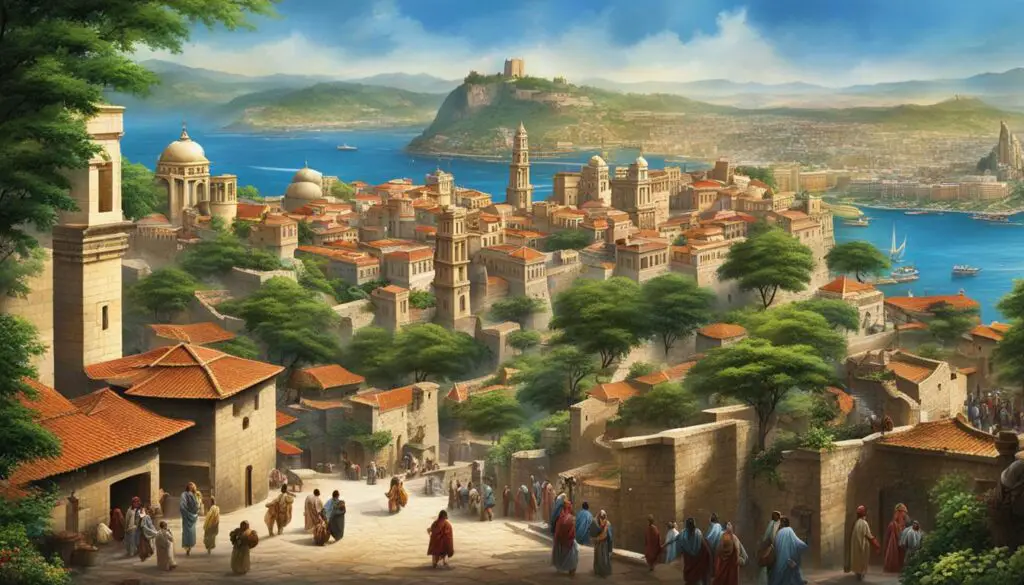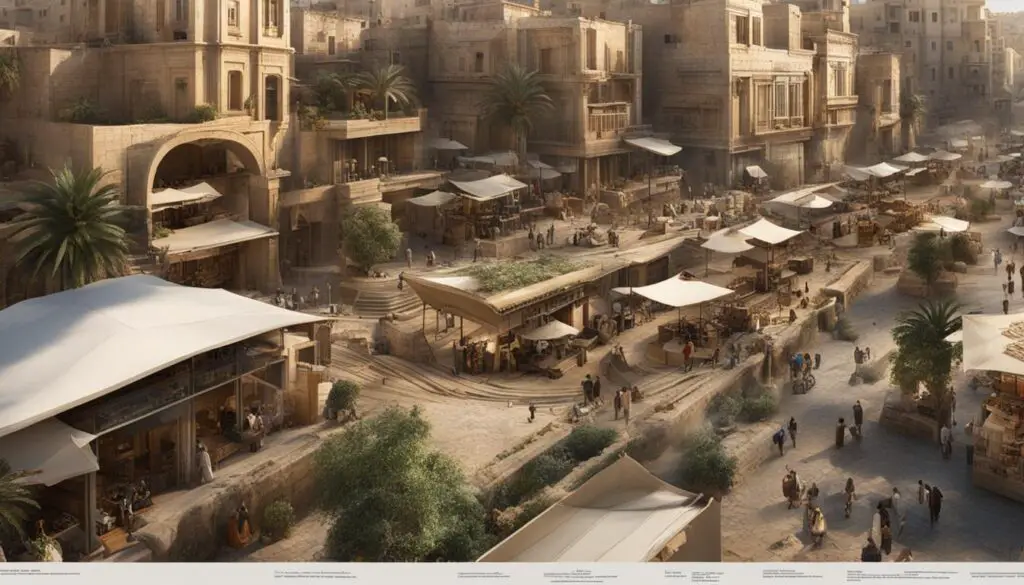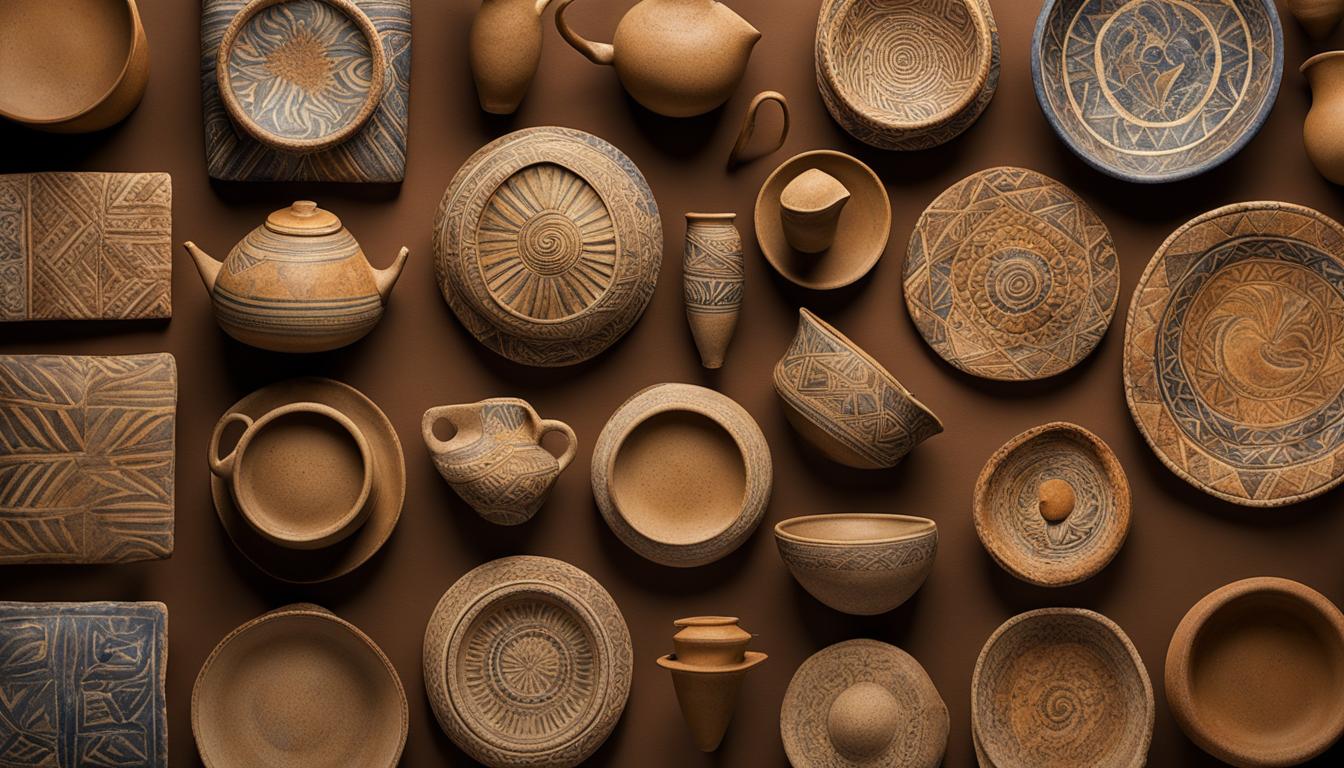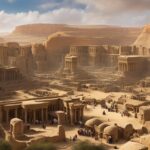Welcome to a fascinating journey through the ancient region of Philistia, a place of immense biblical importance. This historical land, inhabited by the ancient Philistines, holds a rich cultural legacy that has shaped the narrative of the Israelites and influenced the broader historical context of the Levant. Join us as we explore the captivating history, notable biblical figures, appearance and function in biblical times, major events, and modern relevance of Philistia.
Key Takeaways:
- Philistia, an ancient region of great biblical importance, was home to the ancient Philistines.
- Goliath, Delilah, King Achish, and Abimelech are notable biblical figures linked to Philistia.
- In biblical times, Philistia comprised a collection of city-states, each with its own ruler and political structure.
- Major biblical events took place in Philistia, including the encounters between Samson and the Philistines, and the capture of the Ark of the Covenant.
- Today, Philistine artifacts and archaeological discoveries provide valuable insights into their culture, while the study of Philistia enhances our understanding of ancient civilizations and the historical dynamics of the Levant.
The Biblical Significance of Philistia
In the Bible, Philistia holds great significance as it is mentioned repeatedly in connection with the Israelites. The Philistines were one of the major enemies of the Israelites, often engaging in conflict with them. Their presence in Philistia played a crucial role in shaping the narrative of the Israelites’ journey and struggles.
Throughout the Old Testament, we see Philistia as a recurring backdrop to the Israelites’ challenges and triumphs. The Philistines’ military might and cultural distinctiveness set them apart from their neighboring civilizations, creating a distinct dynamic that shaped the course of history. From the famous battle between David and Goliath to the encounters between Samson and the Philistines, the biblical stories involving Philistia offer valuable insight into the complexities of the ancient world.
By exploring the biblical importance of Philistia, we gain a deeper understanding of its role in shaping the historical and cultural landscape of the region. The conflicts between the Israelites and the Philistines highlight the challenges and struggles faced by ancient societies, while also showcasing the resilience and determination of those involved. Understanding the biblical significance of Philistia provides a window into the past and helps us comprehend the broader historical context of the ancient Near East.
The Table of Philistine City-States in the Bible
| City-State | Location | Significance |
|---|---|---|
| Ashkelon | Coastal city in modern-day Israel | Major Philistine stronghold and trading center |
| Ashdod | Coastal city in modern-day Israel | Important Philistine city known for its religious practices |
| Gaza | Coastal city in modern-day Gaza Strip | Key Philistine city with strategic importance |
| Ekron | Inland city in modern-day Israel | Notable Philistine city with connections to the Philistine pantheon |
| Gath | Inland city in modern-day Israel | One of the largest Philistine cities and the hometown of Goliath |
Notable Biblical Figures Linked to Philistia
Philistia, a region of historical significance, is closely intertwined with biblical narratives. Numerous notable figures are linked to Philistia, adding depth and intrigue to its story. These individuals played significant roles in biblical accounts, shaping the narrative of the ancient Near East. Let’s explore some of the prominent Philistine figures mentioned in the Bible.
Goliath
One of the most well-known figures associated with Philistia is Goliath. This formidable warrior, described as a giant, engaged in a legendary battle against the young Israelite hero, David. The story of David’s triumph over Goliath not only showcases courage and determination but also highlights the enduring rivalry between the Israelites and the Philistines.
Delilah
Delilah, another figure linked to the Philistines, is known for her pivotal role in the story of Samson. As Samson’s lover, she conspired with the Philistine leaders to discover the source of his incredible strength and ultimately betrayed him. The tale of Samson and Delilah portrays the allure of power and the consequences of deception.
King Achish and Abimelech
Other biblical figures mentioned in relation to Philistia include King Achish and Abimelech. King Achish, the ruler of Gath, featured prominently in the story of David’s escape from Saul’s persecution. Abimelech, on the other hand, was a king of Gerar and is associated with encounters involving Abraham and Isaac. Their presence in the biblical narrative further emphasizes the historical significance of Philistia.
These notable figures provide glimpses into the complex and intricate relationships between the Israelites and the Philistines. Their stories add depth and intrigue to the historical narrative surrounding Philistia, enriching our understanding of this fascinating region.
The Appearance and Function of Philistia in Biblical Times
In biblical times, Philistia comprised a collection of city-states along the southern coast of the Levant. These city-states, including Ashkelon, Ashdod, Gaza, Ekron, and Gath, were independent entities with their own kings and political structures. Philistia served as a formidable power in the region, exerting influence over neighboring territories.
The Philistine city-states were known for their strategic locations and thriving economies. Situated along major trade routes, these cities became important centers of commerce and cultural exchange. The Philistines engaged in extensive maritime trade, importing luxury goods and exporting their own products, such as pottery and textiles.
Each Philistine city-state had its own distinctive characteristics. Ashkelon, for example, was known for its strong fortifications, protecting it from outside threats. Ashdod, on the other hand, was renowned for its skilled artisans and vibrant artistic scene. Gath, the largest of the Philistine cities, boasted a rich agricultural landscape and played a significant role in the region’s food production.
Table: Philistine City-States in Biblical Times
| City-State | Key Features |
|---|---|
| Ashkelon | Strong fortifications, strategic location |
| Ashdod | Skilled artisans, vibrant artistic scene |
| Gaza | Thriving trade hub, bustling marketplaces |
| Ekron | Rich agricultural landscape, fertile farmlands |
| Gath | Largest city-state, center of agriculture and food production |
The Philistines’ presence in the region created a dynamic and diverse society. Interaction with neighboring peoples, including the Israelites, Canaanites, and Egyptians, influenced their cultural practices and political alliances. Philistine city-states played a significant role in shaping the political landscape of biblical times, leaving a lasting impact on the history of the Levant.

Major Biblical Events in Philistia and Their Impact on History
Philistia, the region of historical significance in the ancient Near East, was the backdrop for several major biblical events that shaped its history and left a lasting impact on the region. These events, intertwined with the narratives of the Israelites and the Philistines, highlight the complex dynamics between these two peoples and their struggles for dominance.
One of the most well-known biblical events that took place in Philistia was the story of Samson, the legendary Israelite hero. Samson’s encounters with the Philistines, including his marriage to a Philistine woman and his battles against them, unleashed a series of events that had far-reaching consequences for both sides. Among these events, the episode of Samson’s strength being sapped by Delilah, a Philistine woman, is particularly memorable.
“Then Delilah said to Samson, ‘Please tell me where your great strength lies, and how you may be bound to afflict you.’ And Samson said to her, ‘If they bind me with seven fresh bowstrings, not yet dried, then I shall become weak and be like any other man.’”
Furthermore, the Philistines’ capture of the Ark of the Covenant, a sacred artifact of the Israelites, had disastrous consequences for them. According to biblical accounts, the Ark was taken to the Philistine city of Ashdod, but it brought turmoil and suffering upon the Philistines, leading them to return it to the Israelites. This event symbolizes the clash of faiths and the divine intervention portrayed in the biblical narratives.
These major biblical events underscore the significance of Philistia as a stage for historical and spiritual conflicts, shedding light on the intricate interplay between the Israelites and the Philistines within the broader context of the ancient Near East.
Major Biblical Events in Philistia
| Biblical Event | Impact on Philistine History |
|---|---|
| Samson’s battles and encounters with the Philistines | Shaped the narrative of the Israelites’ struggles against the Philistines |
| Capture of the Ark of the Covenant | Resulted in disastrous consequences for the Philistines |
The Modern Relevance of Philistia
Although the ancient Philistines no longer exist as a distinct people, their cultural legacy continues to have a significant impact on the region. Philistia, with its rich history and archaeological remains, offers valuable insights into the wider historical context of the Levant and its various civilizations.
The study of Philistia’s cultural heritage contributes to a deeper understanding of the ancient world and its diverse tapestry. Philistine artifacts, such as pottery, jewelry, weapons, and architectural remnants, provide tangible evidence of their way of life. These discoveries not only shed light on Philistine society but also offer a glimpse into the interactions and influences of neighboring cultures.
“Philistia’s cultural impact transcends time, acting as a bridge between ancient civilizations and the present, inviting us to explore the interconnectedness of cultures and their enduring legacy.”– Archaeologist Dr. Emily Carter
Furthermore, the modern relevance of Philistia extends beyond the realm of academia. The recognition and preservation of Philistine heritage foster a deeper appreciation for the cultural diversity of the Levant. By promoting the study and understanding of Philistine history, we can contribute to a more comprehensive narrative of the region’s past, enriching our knowledge of world history as a whole.
Table: Philistine Cultural Legacy
| Aspect | Description |
|---|---|
| Artistic Expression | The Philistines were known for their skilled craftsmanship in pottery, metalwork, and jewelry, showcasing a unique blend of Mediterranean, Aegean, and Canaanite artistic influences. |
| Trade and Commerce | Philistine city-states served as important centers of trade, facilitating economic exchange and cultural interactions between different civilizations in the ancient world. |
| Political Organization | The Philistines’ city-state model of governance influenced the political structures of neighboring regions, leaving a lasting impact on the development of ancient societies. |
| Historical Significance | The Philistines’ role as adversaries of the Israelites and their biblical associations contribute to the broader understanding of the religious, geopolitical, and social dynamics of the ancient Near East. |
The modern relevance of Philistia lies not only in its historical significance but also in its cultural contributions. By preserving and studying Philistine heritage, we can gain a deeper appreciation for the interconnectedness of civilizations and the enduring legacy of this ancient region.

Philistine Artifacts and Archaeology

The archaeological exploration of Philistia has yielded remarkable discoveries, providing valuable insights into the material culture and lifestyle of the ancient Philistines. Excavations in various Philistine sites have unearthed a wide array of artifacts, shedding light on their daily lives, religious practices, and interactions with neighboring cultures.
“The artifacts found in Philistia offer tangible connections to the past, allowing us to piece together the story of this ancient civilization,” says Dr. Sarah Thompson, renowned archaeologist and Philistine expert. “Each discovery adds a new layer to our understanding of their society and challenges preconceived notions.”
Among the notable findings are intricately decorated pottery vessels, including bowls, jars, and oil lamps, adorned with distinctive Philistine motifs and symbols. These artifacts reveal their advanced craftsmanship and the high level of artistic expression prevalent in Philistine culture. Philistine jewelry, such as earrings, bracelets, and necklaces made from gold, silver, and semiprecious stones, provides further evidence of their sophistication and aesthetic sensibility.
The study of Philistine architecture has also been significant, with the excavation of well-preserved structures that offer insights into their cities’ layout and construction techniques. The monumental city gates of Ashkelon and the fortified walls of Ekron are prime examples of Philistine architectural prowess, highlighting their strategic planning and defensive capabilities.
Philistine Artifact Types and Examples
| Artifact Type | Examples |
|---|---|
| Pottery | Decorated bowls, jugs, and storage jars |
| Jewelry | Gold earrings, silver bracelets, semiprecious stone necklaces |
| Weapons | Swords, daggers, arrowheads |
| Architectural Elements | City gates, walls, domestic structures |
These fascinating discoveries not only provide a glimpse into the material culture of the Philistines but also help archaeologists trace their historical connections with other ancient civilizations in the region. The ongoing excavations in Philistia continue to enrich our understanding of this intriguing civilization, further unraveling the mysteries of the ancient world.
Philistine Culture and Society
The culture and society of the ancient Philistines were a fascinating blend of influences from the Mediterranean, Aegean, and local Canaanite civilizations. This unique amalgamation contributed to the distinctiveness of Philistine culture and left a lasting impact on the region.
Philistine society was organized into city-states, with each city-state having its own ruler and administrative system. These city-states, such as Ashkelon, Ashdod, Gaza, Ekron, and Gath, were centers of trade, craftsmanship, and artistic expression. The Philistines excelled in various forms of art, including pottery, metalwork, and jewelry, showcasing their artistic skills and craftsmanship.
The social structure of the Philistines was hierarchical, with the ruling elites holding significant power and influence. The presence of fortified cities and the establishment of a centralized authority indicated a level of political organization and stability. The Philistines were known for their military prowess, and they maintained standing armies to protect their city-states and expand their territorial influence.
The Influence of Philistine Culture
Philistine culture had a significant impact on the wider region, even beyond the biblical narrative. The Philistines’ technological advancements in iron production, agricultural practices, and urban planning influenced the surrounding societies. Furthermore, their interactions with neighboring cultures, such as the Israelites and the Egyptians, led to cultural exchanges and the sharing of ideas.
Philistine culture left an indelible mark on the region, and its influence can be seen in various aspects of ancient Near Eastern civilization. From the art and architecture to the military strategies employed, the Philistines played a vital role in shaping the cultural landscape of the time.
Archaeological excavations have unearthed valuable artifacts, providing insights into the daily life and customs of the Philistines. These discoveries contribute to a better understanding of their material culture, religious practices, and societal norms. The study of Philistine culture sheds light on the diversity and interconnectedness of ancient civilizations, enriching our knowledge of the past.

| Aspect | Philistine Society | Israelite Society |
|---|---|---|
| Political Organization | City-states with independent rulers | Tribal structure with judges and later kings |
| Religious Beliefs | Polytheistic with a focus on deities like Dagon | Monotheistic, worshiping Yahweh |
| Art and Crafts | Skilled in pottery, metalwork, and jewelry | Known for the construction of the Tabernacle and later the Temple |
| Military Strategies | Well-organized armies with advanced weaponry, including chariots | Relying on tribal levies and divine intervention |
The table above highlights some key contrasts between Philistine and Israelite societies. While the Philistines were city-dwelling warriors known for their artistic achievements and strong military presence, the Israelites were a decentralized tribal society with a distinct religious focus and a reliance on divine intervention. These differences in social structure and cultural practices contributed to the complex interactions and conflicts between the two groups.
Philistia in the Context of the Ancient Near East
Philistia, located in the ancient Near East, held a strategic position that shaped its history and influenced its interactions with neighboring kingdoms. Situated in the region known as the Levant, Philistia played a significant role in regional politics and trade, forging connections with various cultures and civilizations.
The Philistines, inhabitants of Philistia, were a distinct people with their own customs and traditions. While their exact origins remain debated among scholars, they are believed to have migrated from the Aegean region, bringing with them a unique blend of Mediterranean and Canaanite influences.
Their presence in the Levant, particularly along the southern coast, placed them in proximity to other influential civilizations, including Egypt and the Israelite tribes. These interactions, both diplomatic and confrontational, contributed to the dynamic nature of Philistia and its role in the larger tapestry of ancient Near Eastern history.

Philistines in the Levant
“The Philistines were a formidable force in the Levant, with their city-states exerting political and economic influence over the region. Their presence and interactions with neighboring kingdoms, such as the Israelites, shaped the political landscape of the ancient Near East.” – Dr. Sarah Williams, Archaeologist
Through archaeological discoveries and textual evidence, researchers have gained insights into the cultural exchanges and conflicts that characterized Philistia’s relationship with other ancient Near Eastern civilizations. These findings not only highlight the importance of Philistia within the larger context of the region but also contribute to our understanding of the complexities of ancient civilizations.
By examining Philistia’s position in the ancient Near East, we gain a deeper appreciation for its historical significance and the interconnected nature of ancient societies. Philistia’s rich heritage continues to captivate scholars and enthusiasts alike, offering valuable insights into the cultural tapestry of the Levant and its enduring legacy.
Philistia Through the Ages
Philistia, an ancient region of historical significance, has undergone various transformations and changes throughout the ages. From its earliest mentions in ancient texts to the rise and fall of the Philistine city-states, the region’s history is a testament to the complexities of the ancient world.
Philistia’s story begins with its biblical significance, as it is repeatedly mentioned in connection with the Israelites. The Philistines, one of the major enemies of the Israelites, shaped the narrative of the Israelites’ struggles and journey. Notable biblical figures, such as the warrior Goliath and the seductive Delilah, are linked to Philistia, adding to its historical importance.
In biblical times, Philistia was a collection of independent city-states, including Ashkelon, Ashdod, Gaza, Ekron, and Gath. These city-states wielded political power and exerted influence over neighboring territories, making Philistia a formidable force in the region. Major biblical events that took place in Philistia, such as the story of Samson and the capture of the Ark of the Covenant, left a lasting impact on its history.
Today, the historical developments in Philistia continue to captivate scholars and enthusiasts. The exploration of Philistine artifacts and archaeological sites provides valuable insights into their material culture, social structure, and interactions with neighboring cultures. Understanding Philistia throughout history contributes to a deeper comprehension of ancient civilizations and the interconnectedness of cultures in the Levant.
Modern Implications of Philistine History and Culture
The ancient region of Philistia holds significant historical and cultural importance, leaving a lasting impact that resonates even today. By exploring the rich history and culture of Philistia, we gain valuable insights that contribute to our understanding of ancient civilizations and their modern relevance. Let’s delve deeper into the modern implications of Philistine history and the enduring relevance of Philistia.
Biblical Significance
“And the Philistines put themselves in array against Israel: and when they joined battle, Israel was smitten before the Philistines.” – 1 Samuel 4:2
Philistia’s biblical significance cannot be overstated. Throughout the Bible, the Philistines were depicted as major adversaries of the Israelites, engaging in conflict that shaped the narrative of the Israelites’ journey and struggles. Their presence in Philistia played a crucial role in the biblical account, leaving a lasting imprint on the collective consciousness.
Archaeological Discoveries
The exploration of Philistine archaeological sites and the discovery of Philistine artifacts continue to provide invaluable insights into their way of life. Pottery, jewelry, weapons, and architectural remains unearthed by archaeologists shed light on their material culture and society. These discoveries not only contribute to our understanding of the ancient world but also offer a comprehensive picture of the diverse civilizations that once thrived in the region.
Appreciation for Cultural Diversity
Recognizing Philistine heritage fosters a deeper appreciation for the cultural tapestry of the Levant. By studying Philistine history, we gain a broader perspective on the interconnectedness of cultures in the ancient Near East and the influences that shaped world history. Philistia’s cultural legacy transcends its ancient borders, enriching our understanding of the complexities and diversity of human civilizations.
| Modern Implications of Philistine History | Relevance of Philistia Today |
|---|---|
| Contribution to biblical archaeology | Enhances understanding of ancient civilizations |
| Valuable insights into the cultural tapestry of the Levant | Recognition of the diverse heritage in the region |
| Appreciation for the interconnectedness of ancient cultures | Enriches our understanding of world history |
As we delve into the modern implications of Philistine history and culture, we uncover a wealth of knowledge that extends far beyond the ancient world. The biblical significance, archaeological discoveries, and appreciation for cultural diversity all contribute to a deeper understanding of our shared human history. Philistia’s legacy continues to inspire and captivate, shaping our understanding of the past and the present.
Conclusion
In conclusion, the region of Philistia holds immense biblical importance and continues to captivate scholars and enthusiasts alike. The ancient Philistines, prominently mentioned in the Bible, played a significant role in shaping the narrative of the Israelites’ journey and struggles. Notable biblical figures such as Goliath, Delilah, King Achish, and Abimelech were linked to Philistia, further solidifying its place in biblical history.
During biblical times, Philistia comprised a collection of city-states along the southern coast of the Levant. These city-states, including Ashkelon, Ashdod, Gaza, Ekron, and Gath, were independent entities with their own kings and political structures. Philistia served as a formidable power in the region, exerting influence over neighboring territories.
Several major biblical events took place in Philistia, leaving a lasting impact on its history. The stories of Samson and the Philistines, as well as the capture of the Ark of the Covenant, are notable examples of these events. These occurrences shaped the course of Philistine history and reverberate through the ages as significant milestones in biblical narratives.
Today, the modern relevance of Philistia lies in its cultural legacy and archaeological discoveries. Philistine artifacts provide valuable insights into their way of life and cultural practices. The study of Philistine history contributes to a deeper understanding of the broader historical context of the Levant and its various civilizations. By delving into Philistia’s rich heritage, we gain a greater appreciation for the interconnectedness of cultures and the enduring impact of this ancient region.
FAQ
What is the biblical significance of Philistia?
Philistia is mentioned repeatedly in the Bible in connection with the Israelites, as the Philistines were one of their major enemies. Their presence in Philistia played a crucial role in shaping the narrative of the Israelites’ journey and struggles.
Who are some notable biblical figures linked to Philistia?
Goliath, the renowned giant, and Delilah, known for her role in the story of Samson, are two notable biblical figures associated with the Philistines. Other figures, such as King Achish and Abimelech, are also mentioned in relation to Philistia in biblical texts.
What was the appearance and function of Philistia in biblical times?
Philistia comprised a collection of city-states along the southern coast of the Levant. These city-states, including Ashkelon, Ashdod, Gaza, Ekron, and Gath, were independent entities with their own kings and political structures. Philistia served as a formidable power in the region, exerting influence over neighboring territories.
What major biblical events took place in Philistia?
The story of Samson and his encounters with the Philistines, including the famous episode of his strength being sapped by Delilah, stands out. Additionally, the Ark of the Covenant, a sacred artifact of the Israelites, was captured by the Philistines and resulted in disastrous consequences for them.
How does Philistia remain relevant today?
Although the ancient Philistines no longer exist as a distinct people, their cultural legacy continues to influence the region. Philistine artifacts and archaeological remains provide valuable insights into their way of life. Additionally, the study of Philistine history contributes to a deeper understanding of the broader historical context of the Levant and its various civilizations.







